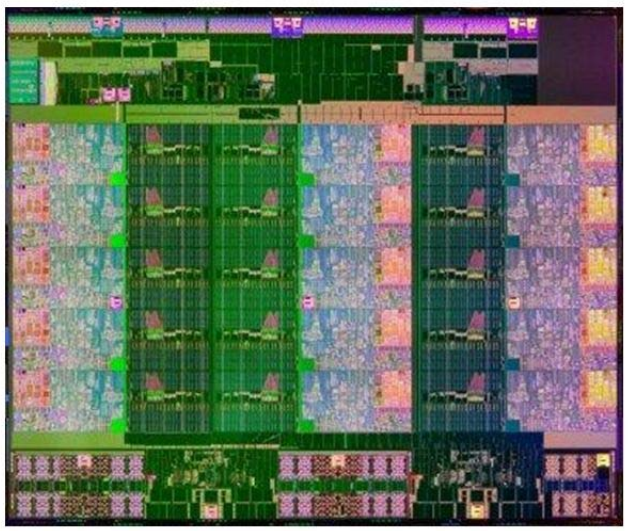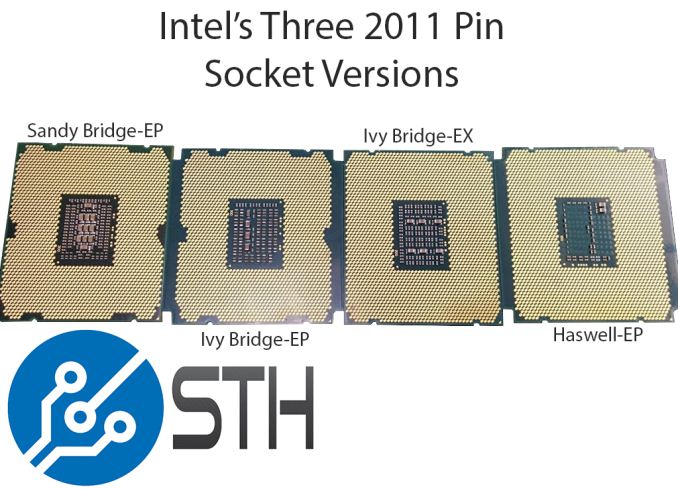Intel’s Three Versions of Socket 2011, Not Compatible
by Ian Cutress on February 20, 2014 9:45 AM EST- Posted in
- CPUs
- Intel
- Xeon
- LGA2011
- Ivy Bridge EX

With our recent discussion regarding Intel’s launch of the 15-core Xeon E7 v2 ‘IvyTown’ processors, thoughts for a lot of high end consumers focused on the underlying hardware for these 4P and 8P systems that would be entering the market. Previously with high end systems there has been a disjunct between the sockets used for the mainstream 1P and 2P processors (-E and -EP) compared to the higher end 4P/8P models (-EX). For example:
With Nehalem/Westmere, the single socket Bloomfield Xeons were LGA 1366.
With Nehalem-EP/Westmere-EP, the dual socket Gainstown Xeons were also LGA 1366.
With Nehalem-EX/Westmere-EX, the quad/octo socket Beckton Xeons were LGA 1567.
With Sandy Bridge-E/Ivy Bridge-E, the single socket Xeons are LGA 2011.
With Sandy Bridge-EN/Ivy Bridge-EN, the single/dual socket Xeons are LGA1356
With Sandy Bridge-EP/Ivy Bridge-EP, the dual socket Xeons are LGA 2011.
With Ivy Bridge-EX, the quad/octo socket Xeons are also LGA 2011, but different.
Reported images of Haswell-EP Xeons also point to LGA 2011, but different again.
Back at ISSCC, when we reported about the talk around the new IvyTown based processors, we lifted the following line from the official documentation:
- “The processor supports two 2011-land, 40-mil pitch organic flip-chip LGA package options”
This produced speculation to whether the processor package for EX would be the same as EP, despite a reconfigured memory controller, additional QPI links and a different pin layout. Given at the time we were under NDA we could not mention they were different, but some investigative work from Patrick at ServeTheHome answers a lot of questions.
Simply put, Ivy Bridge-EP, Ivy Bridge-EX and Haswell-EP all have LGA2011 designations (officially FCLGA2011, for flip-chips), but have different physical mountings in the socket:
Despite the contact patches/‘wings’ on Ivy Bridge-EP, it will fit in the Sandy Bridge-EP socket – the issue is more the pins on Ivy Bridge-EX and Haswell-EP, where on the left and right it is more ‘filled in’, as well as at the corners. The notches for the processors (the indents on the top and bottom) are also different, moving to Ivy Bridge-EX.
The Ivy Bridge-EX and Haswell-EP processors look very similar from these images, despite the extra wings on the Haswell-EP. The key here is the bottom right of the two processors, and count the number of pins between the notch and the edge – Ivy Bridge-EX has four, Haswell-EP has six.
All in all, this may not much of anything – users spending thousands on processors should be making sure that the motherboards they buy have the processor they want listed in the QVL (Qualified Vendor’s List). My concern might be users thinking they can drop a Haswell-EP Xeon into an Ivy Bridge-E, and then trying to force it when it might not fit. Back in previous eras (socket 775 comes to mind) this was an even bigger issue – the processors might fit, but the processors that a motherboard could take was determined by the chipset used by the motherboard manufacturer and the QVL. At least this way the CPUs will not physically fit, but it is something that confuses the situation – it might be worth doing some clever renaming (LGA2011-EX, LGA2011-H), at least from an editorial point of view for the future.
Source: ServeTheHome











47 Comments
View All Comments
Kevin G - Thursday, February 20, 2014 - link
Oh? I could see why a Lynnfield chip wouldn't work with a Z87 chipset: no integrated graphics and it requires a clock input that the Z87 doesn't provide. However, what prevents the opposite? Say a Haswell board on a P55 chipset? Things like the external clock generator could be simply ignored on Haswell. PCI-e speeds would be likely be limited to 2.0 speeds. Otherwise, I'm not seeing much of a real limitation that couldn't have been addressed with a bit of foresight for a one-socket-to-rule-them-all scenario.Things are even more similar between socket 2011 variants. The main differences here don't deal with the chipset but rather socket level features (memory type, PCI-e lanes and QPI links).
TheinsanegamerN - Thursday, February 20, 2014 - link
The only thing that comes to mind is that haswell moved some voltage-control circuits onto the CPU itself. that would probably play havoc with the external voltage control on older boards.piroroadkill - Thursday, February 20, 2014 - link
Intel is obsessed with different sockets, but AMD tries to keep them the same.Intel needs to stop screwing things up. Fuck, add a pin that does nothing and call it 2012 if you want, but they should never have several "2011" which aren't even the same...
willis936 - Thursday, February 20, 2014 - link
They did that with 1155.nekoken - Thursday, February 20, 2014 - link
AMD used to be pretty great for socket compatibility but the aborted FM1 socket kind of ruined that.Flunk - Thursday, February 20, 2014 - link
There was no way around that, You can't get the integrated GPU functionality into an AM3 form-factor.Death666Angel - Thursday, February 20, 2014 - link
Huh? FM1 APUs already had iGPUs (Llano), but AMD decided not to support that anymore with the launch of Trinity. Has nothing to do with the AMx-line and iGPU functionality not being available.TiGr1982 - Thursday, February 20, 2014 - link
Not only FM1 - FM2+ CPU do not fit/work at all in FM2 M/B.That was NOT the case for AM2+/AM2 in the past - these frequently worked together.
So AMD isn't better in this regard these days.
ZeDestructor - Thursday, February 20, 2014 - link
You think this is bad.... Look at the laptop CPUs... Socket 479 from the 110nm Pentium M/Pentium 4 (backwards compatible with S478 chips as I recall too) all the way to the quad-core 45nm mobile Penryn cores, with nothbridges spanning from AGP8x/PCI/IDE/DDR all the way to PCIe/SATA/DDR3...On the other hand, we do have rPGA-988 and rPGA-988B for SB/IVB, so they could have done a lot better naming-wise...
mapesdhs - Thursday, February 20, 2014 - link
The trouble with AMD though is that even when a chip physically fits
a socket ok, often the mbd vendor does not release a BIOS update to
support the chip in question. This happened a lot with the Phenom II;
there are numerous AM2 boards which don't support them due to lack
of BIOS updates.
Ian.